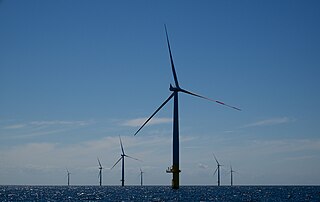
Iberdrola, S.A. is a Spanish multinational electric utility company based in Bilbao, Spain. It has around 40,000 employees and serves around 30 million customers.

EDF Energy is a British integrated energy company, wholly owned by the French state-owned EDF, with operations spanning electricity generation and the sale of natural gas and electricity to homes and businesses throughout the United Kingdom. It employs 11,717 people, and handles 5.22 million business and residential customer accounts.

The United Kingdom is the best location for wind power in Europe and one of the best in the world. The combination of long coastline, shallow water and strong winds make offshore wind unusually effective.

Wind power in Germany is a growing industry. The installed capacity was 55.6 gigawatts (GW) at the end of 2017, with 5.2 GW from offshore installations. In 2020, 23.3% of the country's total electricity was generated through wind power, up from 6.2% in 2010 and 1.6% in 2000.

Denmark was a pioneer in developing commercial wind power during the 1970s, and today a substantial share of the wind turbines around the world are produced by Danish manufacturers such as Vestas—the world's largest wind-turbine manufacturer—along with many component suppliers. Furthermore, Denmark has—as of 2022—the 2nd highest amount in the world of wind power generation capacity installed per capita, behind only neighboring Sweden.

As of 2023, Europe had a total installed wind capacity of 255 gigawatts (GW). In 2017, a total of 15,680 MW of wind power was installed, representing 55% of all new power capacity, and the wind power generated 336 TWh of electricity, enough to supply 11.6% of the EU's electricity consumption.

Wind power generation capacity in India has significantly increased in recent years. As of 31 March 2024, the total installed wind power capacity was 45.887 gigawatts (GW). India has the fourth largest installed wind power capacity in the world. Wind power capacity is mainly spread across the southern, western, and northwestern states. The onshore wind power potential of India was assessed at 132 GW with minimum 32% CUF at 120 m above the local ground level (agl). Whereas, the estimated potential at minimum 25% CUF is 695 GW at 120 agl.
The Siemens Energy Sector was one of the four sectors of German industrial conglomerate Siemens. Founded on January 1, 2009, it generated and delivered power from numerous sources including the extraction, conversion and transport of oil and natural gas in addition to renewable and alternative energy sources. As of October 1, 2014, the sector level has been eliminated, including the Siemens Energy Sector.

Wind power generates about 10% of Turkey's electricity, mainly in the west in the Aegean and Marmara regions, and is gradually becoming a larger share of renewable energy in the country. As of 2024, Turkey has 12 gigawatts (GW) of wind turbines. The Energy Ministry plans to have almost 30 GW by 2035, including 5 GW offshore.

In 2021 France reached a total of 18,676 megawatts (MW) installed wind power capacity placing France at that time as the world's seventh largest wind power nation by installed capacity, behind the United Kingdom and Brazil and ahead of Canada and Italy. According to the IEA the yearly wind production was 20.2 TWh in 2015, representing almost 23% of the 88.4 TWh from renewable sources in France during that year. Wind provided 4.3% of the country's electricity demand in 2015.

EnBW Baltic 1 is the first commercial offshore wind farm of Germany in the Baltic Sea. Siemens supplied 21 SWT 2.3-93 wind turbines for the 48.3 megawatt wind farm. EnBW Baltic 1 is located about 16 kilometres (9.9 mi) north of the Darss-Zingst Peninsula and covers about seven square kilometers. Work started in July 2010; the wind farm was officially commissioned on 2 May 2011.

EDF Renewables is a wholly owned subsidiary of the French utility EDF Group, specializing in renewable energy production. As an integrated operator, the Group develops and finances the construction of renewable energy facilities, and manages operations and maintenance for its own account and for third parties.

As of May 2024, wind power in the Netherlands has an installed capacity of 11,611 MW, 40.9% of which is based offshore. In 2022, the wind turbines provided the country with 18.37% of its electricity demand during the year. Windmills have historically played a major part in the Netherlands by providing an alternative to water driven mills.

In Japan's electricity sector, wind power generates a small proportion of the country's electricity. It has been estimated that Japan has the potential for 144 gigawatts (GW) for onshore wind and 608 GW of offshore wind capacity. As of 2023, the country had a total installed capacity of 5.2 GW.

Wind power in the Philippines accounts for a total of 443MW as of 2020 according to the Department of Energy, covering about 1.6% of the country's total installed capacity for both renewable and non-renewable energy sources. When it comes to existing renewable energy sources in the country, wind power has a total share of approximately 5.4%. Despite currently being a small contributor to the country's energy mix, wind power installations have increased from 33MW in 2012-2013 to 337MW in 2014, 427MW in 2015-2018, and 443MW in 2019-2021. Moreover, the Department of Energy's National Renewable Energy Plan (NREP) 2020-2040 aims to commission 2,345MW of total wind power capacity by 2030. There has been a setback, however, as the wind power industry was moderately affected by COVID, particularly in the import of wind turbines. Due to this, several projects such as the Aklan onshore wind project got delayed. To further drive the wind energy sector in the country, an increased demand for renewable energy, greater government commitments, and reduced wind power tariff are needed.

Renewable energy in Taiwan contributed to 8.7% of national electricity generation as of end of 2013. The total installed capacity of renewable energy in Taiwan by the end of 2013 was 3.76 GW.

Wind power is a major industry in Taiwan. Taiwan has abundant wind resources however a lack of space on land means that most major developments are offshore.
Kriegers Flak is a 605 MW offshore wind farm in the Baltic Sea on the Danish part of the reef of the same name. It forms part of a new 400 MW interconnector between Denmark and Germany.

EnBW Baltic 2 is an offshore wind farm in the German section of the Kriegers Flak reef in the Baltic Sea. The wind farm uses 80 Siemens SWT 3.6-120 wind turbines for a total capacity of 288 megawatt. Baltic 2 is connected to Germany via Baltic 1, but is also connected to Denmark via the adjacent offshore wind farm ″Kriegers Flak″ in 2020, creating a 400 MW AC offshore grid synchronized to the east Denmark network. The cable to Denmark costs €350m, of which €150m comes from the EU.



















